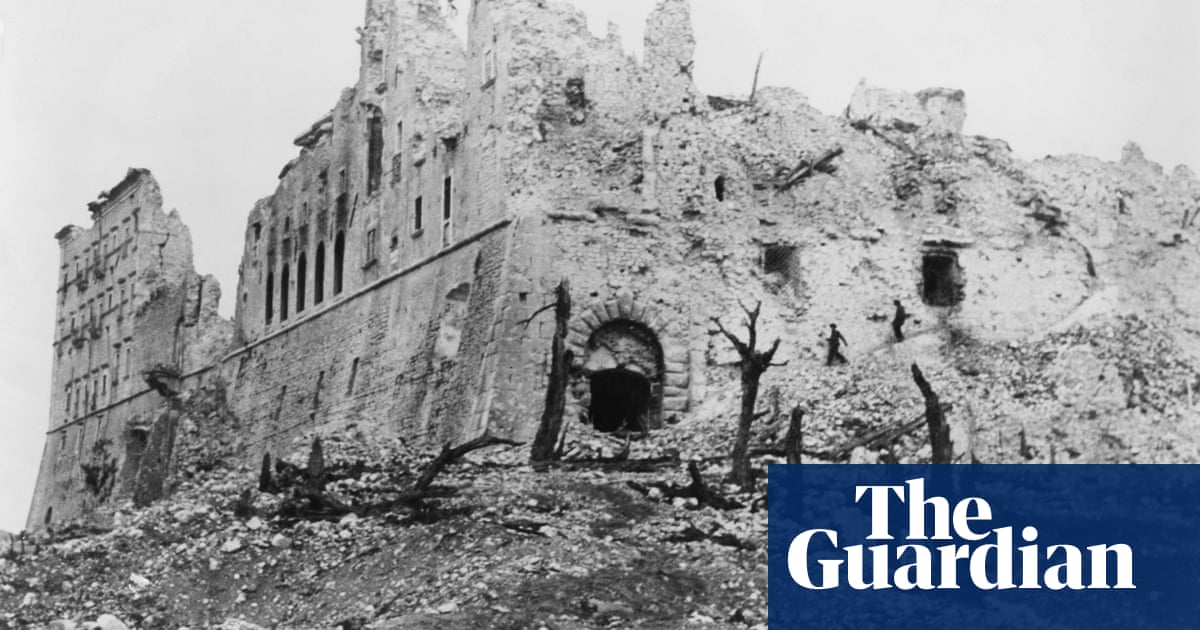
The mountaintop abbey of Monte Cassino ought to have been a place of safety as one of the longest and deadliest battles of the second world war was fought around it.
But on 15 February 1944, 80 years ago this week, about 250 of an estimated 1,000 civilians who had fled to it from the town of Cassino and neighbouring villages were killed when the allied forces bombed the monastery, believing – wrongly – that German troops were inside or using it as an observation post.
The incident during the Battle of Monte Cassino, which was fought during the allied advance to Rome, was one of the most hotly debated episodes of the war – and has remained so.
It is a legacy that has led Nando Tasciotti, an investigative journalist and former special correspondent at the Italian daily Il Messaggero, into the archives for Pope Pius XII, opened by the Vatican in 2020, where he discovered a document he said confirmed Adolf Hitler’s role in the chain of events that led to the attack while revealing the Holy See’s admission the bombing raid might have been avoided had the Vatican taken firm action to enforce a neutral zone in and around the monastery.
“The document confirms the decisive weight that Hitler’s cynical decisions had on that tragic event,” said Tasciotti, who grew up in Cassino and recently accompanied the Guardian on a visit to the monastery, which was rebuilt after the war.
The Benedictine complex is perched on a rocky summit 521 metres (1,710ft) above the Liri valley and is crossed by Via Casilina, a primary route to Rome. German troops had made it impenetrable to the allies who had landed in Salerno the previous September through their so-called Gustav Line, a defence in central Italy running from the Tyrrhenian to Adriatic coasts through the monastery. A stronghold was established as the allies approached, making the route impossible to pass without a battle for the summit.
Both the Germans and the allies had assured the Vatican in October 1943 that the monastery, which contained the remains of its founder, Saint Benedict, and a trove of thousands of ancient relics and historical masterpieces, would not be attacked or used for military purposes. But as German defences were built up near its walls, its 78-year-old abbot, Gregorio Diamare, grew increasingly concerned and protested. A German captain told Diamare on 12 December 1943 that his high command had decided to establish a military exclusion zone within a 300-metre radius of the monastery, but on 23 December Hitler ordered the defence on Monte Cassino to be raised to “fortress strength”. By 7 January the neutral zone no longer existed and the signs delimiting it were removed.
The first of what would ultimately be four phases of the allied assault began on 12 January 1944 when German troops were already hunkered down in the caves below the walls of the abbey, well within the previous neutral zone, and were using them as observation posts and as a depot for bombs and weapons. Nightly, two tanks were firing on the allies, who immediately took cover under the monastery’s huge silhouette.
In the mistaken belief that the Germans were inside or using it as an artillery observation post, the second phase of the assault began with the bombing of the abbey. Alongside the many civilian dead there was no military breakthrough: the infantry attack on the summit failed and the Germans settled in the ruins, delaying the liberation of Rome by several months.
The civilians died believing they were safe. The allies knew they were inside, and, since that day, there have been questions over a bombing that the US general Mark Clark, the allied operational commander who led the advance on Rome, called a “tragic mistake”.
In a four-page handwritten note published for the first time this month in an updated edition of Tasciotti’s 2014 book, Monte Cassino 1944: Who Was to Blame, Armando Lombardi of the Holy See’s diplomatic service pondered whether the monastery could have been saved if the Vatican had taken firm action against the Germans’ abandonment of the neutral zone and pressed both sides to respect it.
In the note written just after the liberation of Rome in early June 1944, Lombardi said the Vatican was informed by one of the monastery’s monks on the day the first assault began that the Germans had abolished the neutral zone but took no action.
“One has the impression that after the first 10 days of January [1944], ie during the most critical period, the secretariat of state took no interest in the matter,” he wrote.
“On 12 January 1944, a monk, Father [Tommaso] Leccisotti, informed the secretariat that the German authorities had abolished the neutral or protection zone: this was a very serious matter, which should have presaged the catastrophe. But nothing was done and nothing was said about it.”
“Those who are now studying the question calmly are inclined to believe that the monastery could perhaps have been saved if the principle of the neutral zone had been accepted and respected by both belligerents. With an energetic action, the Holy See could perhaps have obtained this,” Lombardi added.
Tasciotti said the note showed Hitler’s actions had primarily put the monastery and those sheltering in it at risk: “Firstly, by pivoting his Gustav Line right on that sacred mountain. Then, by abolishing the 300-metre neutrality zone.
“The Germans were never inside the monastery but were situated right below its walls, where they had a military advantage. In the aftermath of the war, The Hague convention and Unesco strengthened rules even for the use of the ‘immediate surroundings’ of historical, cultural and religious monuments.”
About 300 of the civilians had crammed into a stairwell behind the monastery’s large entrance door. The tiny square in front of the door, inscribed with Pax, the Latin for peace, now marks the scene where many died. “They tried to escape outside and immediately, here, they lost husbands, wives, children, parents … in a second,” Tasciotti said. “They thought they were in the safest place in the world.”
More than 170 of the civilians died when the ceiling of the monastery’s carpentry room collapsed.
On the day before the bombardment, the allies had dropped thousands of leaflets on the monastery urging people to leave. “But how could they, without a truce agreed between the Germans and the allies?” Tasciotti said.
The battle ended on 18 May 1944 after the remains of the monastery were conquered by Polish troops. Today, there are almost 50,000 graves in the various military cemeteries around Monte Cassino.
“Hitler was primarily responsible for the attack, the Vatican’s ‘telegram diplomacy’ proved ineffective, while in bombing the abbey the allies committed a tragic error,” said Tasciotti. “[But] the commitment of allied leaders and soldiers from more than 20 nations gave us the freedom and democracy that we have enjoyed for more than 80 years … in a Europe that needs to be even more united to stop this from happening again.”












